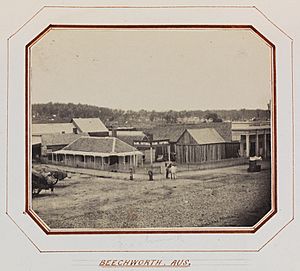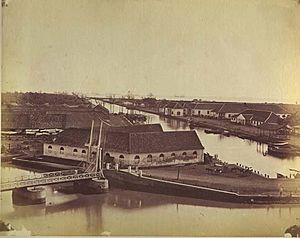Walter B. Woodbury facts for kids
Quick facts for kids
Walter B. Woodbury
|
|
|---|---|
 |
|
| Born |
Walter Bentley Woodburry
26 June 1834 Manchester, England
|
| Died | 5 September 1885 (aged 51) |
| Known for | Woodburytype process |
Walter Bentley Woodbury (born June 26, 1834 – died September 5, 1885) was an inventor and a very early photographer from England. He took some of the first photos in Australia and the Dutch East Indies (which is now part of Indonesia). He also invented many things for photography. His most famous invention was the woodburytype process, a special way to print photos.
Contents
Early Life and Adventures
Walter B. Woodbury was born in Manchester, England, on June 26, 1834. His father passed away when Walter was only 12 years old. After his mother got married again, he went to live with his uncle.
In 1848, he finished school and started working as a trainee artist at a company that designed buildings in Manchester.
In his free time, Walter became very interested in photography. He taught himself how to take and develop pictures. He was good with machines and even built his own simple cameras, called camera obscuras, using cigar boxes and eyeglass lenses.
In 1851, a lot of gold was found in Australia. This made many young men from the United Kingdom want to go there and try to find their fortune. Walter Woodbury was one of them. He sailed to Australia with three friends on July 5, 1852. His mother helped pay for his trip and gave him some spending money.
Life in Australia
Walter was 18 years old when he arrived in Melbourne, Australia, in October 1852. He planned to look for gold right away. But he heard it was very hard to find, so he changed his mind.
He found a job driving a wagon, taking supplies to the gold fields. He slept by the road at night with a bag of oats as a pillow. For a short time, he also worked as a cook at a small hotel on the way to the gold fields.
Next, he worked as an artist for a surveyor's office. He copied maps of land plots in South Melbourne. During this time, he lived in a tent city because places to rent were hard to find and expensive. His boss was a surveyor named William Dawson. They worked in the countryside of Victoria. In February 1853, they surveyed land for the town of Meredith and planned a new road from Geelong to Ballarat. Walter liked his boss and even taught him photography.
After that, he worked as an artist for an office that planned water systems in Melbourne. He took photos of water pipes and other waterworks being built for the Yan Yean Reservoir. He also photographed different buildings in Melbourne. His work was very good. He even won a medal in 1854 for "9 views of Melbourne, taken by the collodion process on glass." This means he took photos on glass plates.
Walter decided to try to make a living from his photography. He traveled through central Victoria, visiting towns like Kyneton. He and another young man named Spencer then went to the gold fields in the north-east. They wanted to take portraits of the miners. They stayed for a few months in the gold-mining town of Beechworth. There, they set up a studio and took pictures of the Spring Creek and Woolshed Creek gold diggings.
By December 1855, Walter had his own portrait photography studio in North Melbourne. That year, he created the first panoramic photo in Australia. It was a series of photos of Melbourne taken from a tall tower. By April 1857, he was selling special 3D-like pictures, called stereoscopic views, of Melbourne and its surroundings.
Around the mid-1850s, Woodbury met another British photographer named James Page. In 1857, they both left Melbourne and sailed towards Japan, China, and the Philippines. They arrived in Batavia (now Jakarta), in the Dutch East Indies, on May 18, 1857. They decided to stay there and started a photography business together called Woodbury & Page that same year.
Adventures in Java, Sumatra, and Borneo
During most of 1858, Woodbury & Page took photos in Central and East Java. They took large pictures of old ruined temples near Surakarta, among other things. By December 8, 1858, Woodbury and Page had returned to Batavia.
In 1859, Walter Woodbury went back to England. He arranged for a company in London, Negretti and Zambra, to sell Woodbury & Page photographs in England. He also made sure they would have a regular supply of photography materials.
Woodbury returned to Java in 1860. For most of that year, he traveled with Page and Walter's brother, Henry James Woodbury, who had arrived in Batavia in April 1859. They explored Central and West Java.
Woodbury & Page sold many types of photos. They had pictures of landscapes, temples, and portraits of important Dutch officials and Indonesian royal family members. They also had a large collection of photos of local people, like craftsmen, servants, dancers, musicians, and food sellers. These photos were sold to tourists and Dutch officials as single postcards or in albums. They also took special photos of local leaders and their groups. The company often advertised their photos and services in newspapers.
On March 18, 1861, Woodbury & Page moved to a new building in Batavia. The studio was renamed Photographisch Atelier van Walter Woodbury, also known as Atelier Woodbury. The company sold portraits, views of Java, 3D-like pictures (called stereographs), cameras, lenses, and other photography supplies. This studio stayed open until 1908.
During his career, Walter Woodbury took photos of places, people, and especially portraits. He photographed in Australia, Java, Sumatra, Borneo, and London. Even though individual photographers were not often named on Woodbury & Page photos, Walter B. Woodbury sometimes stamped his photos with "Photographed by Walter Woodbury, Java" between 1861 and 1862.
Return to England and New Inventions
In early 1863, Walter Woodbury left Java and returned to England because he was not feeling well.
Once back in England, Woodbury invented the Woodburytype process. This was a special way to print photos that looked very real. He received a patent for it in 1864. Between 1864 and 1885, Woodbury got more than 30 patents in Britain and other countries. These inventions were for things like taking photos from balloons, making clear photo slides, and improving projectors and 3D viewers. Besides his inventions, Woodbury also took photos showing the lives of poor people in London.
In 1865, his Woodburytype process was bought by a company called Photo Relief Company. Then it was bought by the Woodbury Permanent Photographic Printing Company, and later by other companies in Britain and elsewhere.
Family Life
Walter Woodbury married Marie Sophia Olmeijer in 1863. They had eight children together.
Death and Legacy
Walter B. Woodbury passed away on September 5, 1885, while on vacation in Margate, England. He was buried at Abney Park Cemetery in Stoke Newington, near London. His family's memorial stands there today. His gravestone says he was a "photographic artist."
Some of his photographs are kept in important museums. These include the Victoria and Albert Museum and the National Gallery of Australia. The Rijksmuseum in Amsterdam and the National Science and Media Museum in Bradford also have his work.
|







